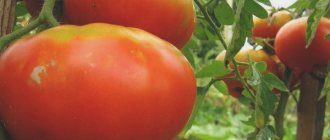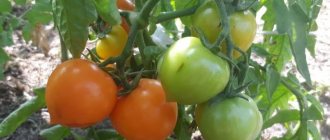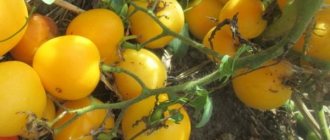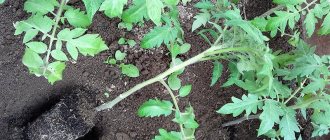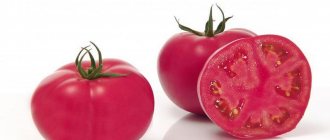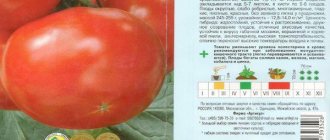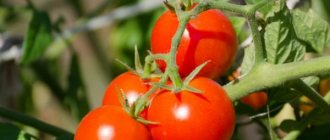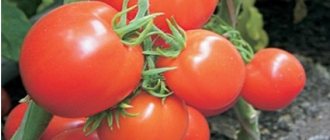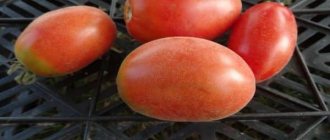A good variety can change the way we think about farming. Especially when it comes to the Carbon tomato. It’s not only the collection of beautiful and tasty tomatoes that brings pure pleasure, but also the simple process of growing them.
| Height | Landing location | Ripening time | Fruit color | Fruit size | Origin | Fruit shape |
| Medium height | Greenhouse, Open ground | Mid-season | Bicolor | Large | Variety | Flat-round |
Description and characteristics of the variety
Tomato Carbon is an indeterminate variety with medium-sized bushes. They are characterized by the following signs:
- powerful strong shoots;
- trunk height up to 1.5 m;
- average foliage and branching;
- need for fixation;
- 5-6 tomatoes on the bunches.
Ripening begins in the middle period - 110-125 days from germination.
The bush grows all the time while the crop is ripening. Be sure to carry out regular stepsoning.
Tomato Description:
- average weight 250-300 g;
- chocolate-burgundy coloring;
- the flesh is fleshy, oily, dark crimson in color at the break;
- seed chambers 4-6;
- sugar level 5-6%.
The taste is predominantly sweet, with light spicy undertones.
Description of tomato as a crop
Tomato is a perennial and annual vegetable crop from the nightshade family. It has an erect stem with numerous branches and deep ribbing. The height of the bush depends on the variety and can be 35-200 cm. The fruits of the tomato are berries, and they are often called tomatoes, fleshy, of different colors and taste characteristics, inside they contain chambers with numerous seeds.
A culture appeared around 800-200 BC. e. in South America, and now a large number of varieties and hybrids have been developed. The plant is grown everywhere in many parts of the world in open and closed ground conditions, and even in apartments and on balconies.
Tomatoes contain many useful substances and vitamins:
- Cellulose.
- Acids.
- Carotene.
- Mineral salts.
- Vitamins of the BB, P, C, K groups.
- Iron.
- Iodine.
- Calcium.
- Chlorine.
- Phosphorus.
Some tips for growing tomatoes in a greenhouse
Let's look at a few tricks that have been tried many times by experienced gardeners:
- You can cut off several underdeveloped fruits from the bunches so that the rest become larger and stronger. Gardeners can tell many stories about how they managed to grow tomatoes weighing up to 1 kg. This is hard to believe, but it has been proven that by removing one or two fruits from a branch you can get larger tomatoes.
- In one greenhouse it is recommended to combine varieties of different types: indeterminate and determinate, early-ripening and late-ripening, salad and pickling. This will allow you not only to get a rich harvest from each bush, but also to please yourself with different tastes. Even if any variety does not live up to expectations, you will still not be left without a harvest, and at the same time you will be able to draw conclusions about what is best to change in the arrangement of bushes in the greenhouse.
- To increase the yield from a bush, it is recommended to remove several lower ovaries from it. Oddly enough, they are the hardest for the plant to fill, and if they are removed, the remaining fruits will be larger and tastier. This is one of the tricks familiar to experienced gardeners: by freeing a young plant from the first fruits, you can get a much more abundant harvest.
- Another simple trick: flowering and fruiting can be accelerated if the concentration of carbon dioxide in the atmosphere is increased. To do this, you can place a bucket of manure in the greenhouse: accelerating biochemical processes will be harmless to the plants, and the result can exceed all expectations.
These recommendations work for both determinate and indeterminate varieties. If you combine tomatoes and grow the next generation from seeds, you can get interesting hybrids that combine the features of both varieties. Many folk breeders are trying to improve ordinary tomato varieties, eliminating common shortcomings.
The space between them must be ventilated, otherwise there is a risk of late blight. This is a serious disease that can completely destroy the crop, and even serious treatment with pesticides cannot save it. However, simple knowledge of agricultural technology will prevent the occurrence of such a scourge.
Basic rules for caring for tomatoes:
- We decide on the variety according to the expected result. To get an early harvest, we choose determinate varieties; if we want more fruits, we give preference to indeterminate varieties.
- We choose a place to plant seedlings taking into account the characteristics of the variety and the climatic conditions of your region (greenhouse or open ground).
- As they grow, indeterminate tomatoes are carefully rooted and tied to a support along the entire length of the stem.
- Tomatoes of determinate varieties are fed in a timely manner (during the period of mass flowering, ovary formation and fruit ripening).
- We regularly ventilate greenhouses to maintain optimal temperature and humidity.
- Properly organized watering (at the root), loosening the soil and hilling will strengthen the health of plants and increase immunity to infectious diseases.
Carbon Reviews
Having studied the reviews on numerous forums, you can see that there are many more positive characteristics than negative ones.
Carbon tomatoes are loved by summer residents for their taste, large fruits, productivity and ease of cultivation. Among the shortcomings, the unevenness and tuberosity of the fruit are often noted.
The Carbon variety, tested by vegetable growers and quite early ripening, gives an excellent harvest and pleases with its taste. The juicy, fleshy fruits are great for fresh consumption and making tomato juice, and even an inexperienced grower can handle the care and cultivation.
And those summer residents who have tried to grow the plant on their own even classify Carbon as a collectible tomato variety.
More information about the Carbon variety - in the video:
We have discussed the main points regarding the fruits of tomatoes of the Carbon variety . They take place if the basic rules of growing, watering and feeding are observed. Color and taste largely depend on the amount of light provided to the fruit.
Features of sowing seeds and growing seedlings
It is recommended to sow seeds for seedlings 60 days before planting the plants in their permanent place of growth. Initially, all seeds are sown in a common large container, where they germinate within a week. The first shoots may appear earlier if the ambient temperature is favorable. As soon as two or three fairly large leaves are formed on the plants, they are planted in separate pots to strengthen the root system. This guarantees better adaptation of tomatoes in the soil and faster rooting.
If you plan to plant bushes in open ground, experts recommend starting to take the seedlings outside for a short period of time one to two weeks in advance so that they can acclimatize. This way you will shorten the rooting period of plants.
The planting density depends on how many main stems are planned to be left on the bushes. If pinching involves two main stems, then it is better to plant three plants per square meter. Four bushes can be placed in the same area when formed into one stem. It is not recommended to violate the density of the arrangement, because in this case the harvest will be worse, as will the characteristics of the ripened fruits.
Main differences between varieties
Describing the differences between these types of tomatoes will help you choose from the many varieties that will best suit your needs and expectations.
All plants that have restrictions in their growth are classified as determinant. In contrast, tall ones are called indeterminate.
Determinate tomatoes are varieties of tomatoes that grow to a maximum of 70 cm and stop growing with the formation of a fruit ovary at the end of the main shoot. Further development occurs on the side shoots (stepchildren).
What are indeterminate tomatoes? The fruits of these crops are placed on a central stem, which reaches 2-4 m in height.
The question is relevant if the seeds or seedlings were given to you by the friendly owner of a neighboring summer cottage and you do not know exactly what category the plants belong to.
Tomato variety Carbon (Carbon)
Gardeners who collect unusual varieties of tomatoes have probably heard about the overseas miracle - the aronia tomato Carbon (original name Carbon). An exotic vegetable native to America. In his homeland in 2005, he won the Heirloom Garden Show competition in the category for the best taste. Carbon is not included in the State Register of Breeding Achievements of Russia. According to numerous reviews, this is one of the few chokeberries for open ground that delights in taste. Not a hybrid.
Description
The plant is described as indeterminate, medium-sized. The height in open ground is about 1 meter, in protected ground - 1.5 meters. A distinctive feature of the variety is the independent cessation of growth when a certain number of brushes are formed. The bushes are strong, the stems are powerful, shoot formation is good, the foliage is average. The leaves are of the usual type, slightly wrinkled, dark green, medium in size. Inflorescences of a simple type. Pedicel with articulation. Each fruit cluster has from 3 to 7 ovaries. There are at least 5 inflorescences on the main stem, so we can talk about the excellent load of the bush.
The fruits are flat-round, with cheeks. An unripe tomato is green in color, with a dark spot at the base. When ripe, it becomes dark red, with a chocolate tint, especially noticeable near the stalk. The pulp of the variety is brick-red in color, fleshy, juicy, multi-chambered (more than 6 chambers), but the seed nests are small, with a small number of seeds. The consistency of the pulp is quite dense. The taste is excellent. The pulp is aromatic, very sweet, and a subtle astringency adds piquancy to the taste. Our hero also captivates with his large fruit. The weight of tomatoes is from 200 to 300 grams.
Characteristics
- Carbon is classified as mid-season. The ripening of delicious tomatoes begins 110 - 120 days after germination;
- Fruiting is long, the plant will work until frost. According to some reports - until October;
- as tomato growers have noticed, the ovary appears quite quickly, but you have to wait a long time for ripening;
- There is no exact information about yield. But the tomato is described as very productive, as evidenced by the large number of inflorescences on the bush and the mass of fruits. According to reviews from gardeners, including American ones, the productivity of the variety is above average. Carbon shows the best results in protected ground;
- tomatoes are resistant to cracking. But if you do not maintain normal soil moisture, problems cannot be avoided;
- there is information that the plant suffers from the heat - the leaves burn and the fruits get burned and become softer;
- Regarding immunity, conclusions can only be drawn from reviews. And they are mostly positive, which indicates the variety’s good resistance to diseases;
- Transportability is not bad, considering the density of the tomatoes. Keeping quality also allows the crop to be stored for some time;
- The method of use is universal. First of all, our hero is grown to use tomatoes in their natural form - in salads, on sandwiches. But the fleshy pulp is perfectly processed into juice and paste. True, some gardeners don’t really like the color of the finished product, but it tastes wonderful.
Agricultural technology
Carbon is grown using seedlings. It is better to calculate the sowing time yourself, taking into account climatic conditions. The recommended planting density is no more than 4 bushes per 1 square meter. Tying to a support is a necessary procedure, as is pinching. In order for the culture to show maximum results, it is formed into 2 stems. Agricultural technology is simple. The only caveat is that you should not get carried away with nitrogen when feeding.
Carbon is an unusual and very tasty variety. During the ripening period, when numerous fruits begin to ripen, any vegetable grower will be proud of the results of his work. And he will experience even greater delight when he tastes sweet tomatoes. The variety is unpretentious and hardworking, so most gardeners leave it in their collection. You can collect the seeds yourself.
How to grow seedlings?
Seeds are sown two months before the intended planting at the main place of their germination. Sowing is done in a large container, where they sprout and grow until one or two leaves are formed. Germination time should be no more than a week. After the leaves have formed, the seedlings are planted in separate pots so that their root system is formed and strengthened.
If the area for planting tomatoes is in open ground, then the seedlings need to be gradually adapted to the environment where they will grow and bear fruit. To do this, they are taken outside for several hours.
Seedlings are planted depending on how the bush is planned. If it grows in one stem, then four seedlings can be planted per square meter. In the case where one stem is planned, there should be three seedlings per square meter.
Plants should not be planted densely, because in this case the fruits will be small, and in addition, the yield itself will be significantly lower . In addition, tomatoes should never be planted next to potatoes. The stems need to be treated against pests and various diseases, such as late blight.
Pest and disease control
The pests and diseases that occur on this variety do not differ from the usual ones; these can be: fungal diseases, late blight, fruit cracking, phomosis, aphids, spider mites.
Fomoz - looks like brown spots of rot pressed into the fruit. The disease is provoked by high humidity and excessive nitrogen content in the soil. Damaged fruits are all destroyed, and the bushes themselves are treated with special means.
Prevention of late blight is the correct proximity (cannot be planted next to potatoes), crop rotation is observed, fertilizers are applied in a timely manner, and the plants are regularly sprayed with anti-disease products.
Cracking of fruits occurs if the watering regime is irregular: either too rare or excessive. Unripe tomatoes are especially susceptible to cracking, and infection can get into the cracks and rotting can begin.
Both various folk remedies and specialized preparations that can be purchased at a flower or hardware store help against aphids.
The spider mite is a small red spider that envelops plants in its web and drinks juice from the leaves and stems. They cope with it using folk remedies and spraying Karbofos.
Planting and care
Growing will require vegetable growers to comply with a combination of the following actions.
Choosing a favorable landing site and preparing it
The plant loves well-lit areas, slightly acidic soil or neutral acidity, it should be well drained, nutritious and light. Therefore, before planting, take care of the timely application of rotted organic fertilizers and spill with a weak solution of potassium permanganate for disinfection.
Proper watering
Watering is required frequently, but not too much. The top layer of soil must dry out before the next watering. Lack of moisture leads to wilting and drying out of the bush, and excess moisture leads to the appearance of fungus, various diseases and pests on the plant.
Loosening and weeding
Loosening provides access to the necessary oxygen to the root system. It is necessary to regularly loosen the soil around the trunk and remove weeds in a timely manner.
Fertilizer application
Before planting, organic fertilizers are applied, and the first fertilizing should be special potassium preparations.
After 25-30 days, foliar feeding is done by spraying on a cloudy day. If necessary, feeding at the root is repeated one more time during the season.
Trimming and forming 2-3 stems
Tying ensures the safety of the plant, and this process begins when the bush reaches 35-40 cm. For tying, you will need a soft rope, two stakes 1 meter high and higher, they are located opposite.
They tie up the bushes, making sure that the shoots and the central trunk rest on the ropes and do not interfere with each other, and that the ropes themselves do not fit tightly to the trunk and branches; a gap must be left.
